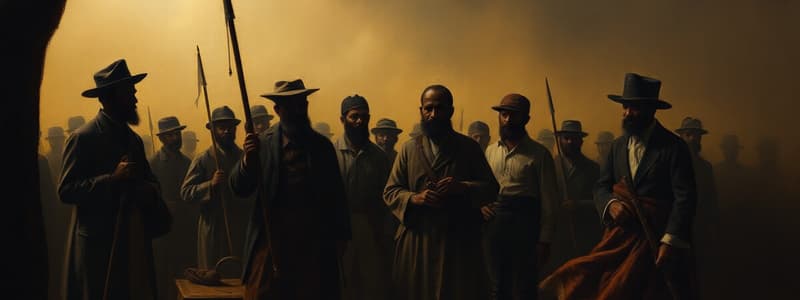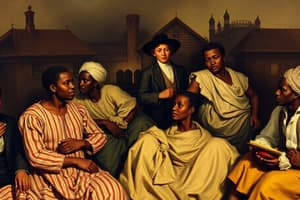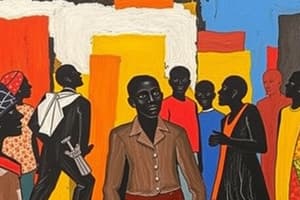Podcast
Questions and Answers
What was the primary goal of Southern politicians in the 1850s?
What was the primary goal of Southern politicians in the 1850s?
- To maintain the legality and viability of slavery (correct)
- To promote industrial growth in the South
- To abolish slavery gradually
- To integrate the South's economy with the North
What was the main purpose of the Missouri Compromise?
What was the main purpose of the Missouri Compromise?
- To provide financial aid to slave owners
- To maintain a balance between free and slave states (correct)
- To establish a new trade route with Mexico
- To ban slavery in all US territories
What event led to the United States acquiring vast new territories in the West?
What event led to the United States acquiring vast new territories in the West?
- The Louisiana Purchase
- The War of 1812
- The California Gold Rush
- The war with Mexico (correct)
Which territory's application to the Union as a free state threatened the balance between free and slave states?
Which territory's application to the Union as a free state threatened the balance between free and slave states?
What was a key component of the Fugitive Slave Act?
What was a key component of the Fugitive Slave Act?
What was the impact of the Fugitive Slave Act on escaped enslaved people and free Black people?
What was the impact of the Fugitive Slave Act on escaped enslaved people and free Black people?
What effect did the Compromise of 1850 have on the nation?
What effect did the Compromise of 1850 have on the nation?
What was Harriet Beecher Stowe's primary tool in the fight against slavery?
What was Harriet Beecher Stowe's primary tool in the fight against slavery?
What is the name of Harriet Beecher Stowe's most famous work?
What is the name of Harriet Beecher Stowe's most famous work?
What impact did 'Uncle Tom's Cabin' have on public opinion regarding slavery?
What impact did 'Uncle Tom's Cabin' have on public opinion regarding slavery?
Flashcards
Missouri Compromise
Missouri Compromise
An agreement in 1820 that maintained the balance of free and slave states, temporarily postponing conflict.
Fugitive Slave Act
Fugitive Slave Act
Citizens were required to assist in the recovery of runaway enslaved people; denied jury trial rights.
Underground Railroad
Underground Railroad
A network of secret routes and safe houses to help enslaved African Americans escape to freedom.
Uncle Tom's Cabin
Uncle Tom's Cabin
Signup and view all the flashcards
Harriet Beecher Stowe
Harriet Beecher Stowe
Signup and view all the flashcards
Secession
Secession
Signup and view all the flashcards
Study Notes
- By 1850, the U.S. was politically tense, with both pro- and anti-slavery advocates ready to ignite conflict.
Southern Stance
- Southern slave owners held political power, aiming to maintain slavery's legality and balance the number of free and slave states.
- Secession was the South's planned response if these goals were not met.
Northern Stance
- Moderate abolitionists, like Harriet Beecher Stowe, used writing to expose slavery's horrors.
- Militant abolitionists, like John Brown, were willing to use political means or violence to fight slavery.
- Abolitionists believed their cause was morally right and were prepared for war to end slavery.
Attempts at Compromise
- Moderate politicians sought to prevent war by appeasing Southern slave owners.
- The Missouri Compromise of 1820, led by Henry Clay, temporarily balanced free and slave states.
Territorial Expansion
- Victory in the war with Mexico in 1848 created tension regarding slavery's expansion into newly acquired territories.
- The question was raised whether new states would be slave or free, and whether inhabitants could decide.
- California's petition to join the Union as a free state threatened the balance.
Compromise of 1850
- California was admitted as a free state.
- Citizens in other states would vote on the slavery issue.
- The Fugitive Slave Act was passed, requiring citizens to assist in capturing runaway slaves and denying fugitives a jury trial.
- The federal government was given more responsibilities to enforce slavery laws.
Impact of the Fugitive Slave Act
- The act enabled slave owners to hire catchers to return escaped slaves to bondage.
- It led to violations of human rights, causing many formerly enslaved and free Black people to flee to Canada and Europe.
- Abolitionists were further motivated, leading to increased activity in the Underground Railroad.
- Although the Compromise of 1850 temporarily preserved national unity, it deepened divisions over slavery.
Harriet Beecher Stowe
- Harriet Elizabeth Beecher Stowe (1811-1896) used her writing to combat slavery.
- The Fugitive Slave Act motivated Stowe and others to become more active in the anti-slavery movement.
- Stowe is the author of "Uncle Tom's Cabin", an influential work of abolitionist literature.
- Stowe toured the North and Europe, promoting her book and the abolitionist cause.
Uncle Tom's Cabin
- The book featured memorable characters such as Uncle Tom, Simon Legree, and Eva, to illustrate the inhumanity of slavery in a personal way for readers.
- Stowe's characters became archetypes in later stories and movies about slavery.
- "Uncle Tom's Cabin" had a powerful impact, swaying many moderates to become abolitionists.
- Stage adaptations of the story were particularly effective in evoking emotions from audiences.
Studying That Suits You
Use AI to generate personalized quizzes and flashcards to suit your learning preferences.




